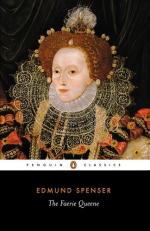Spenser’s essay on A View of the Present State of Ireland shows that, far from shutting himself up in a fool’s paradise of fancy, he was fully awake to the social and political condition of that turbulent island, and that it furnished him with concrete examples of those vices and virtues, bold encounters and hair-breadth escapes, strange wanderings and deeds of violence, with which he has crowded the allegory of the Faerie Queene.
II. THE AUTHOR OF THE FAERIE QUEENE
Edmund Spenser was born in London near the Tower in the year 1552. His parents were poor, though they were probably connected with the Lancashire branch of the old family of Le Despensers, “an house of ancient fame,” from which the Northampton Spencers were also descended. The poet’s familiarity with the rural life and dialect of the north country supports the theory that as a boy he spent some time in Lancashire. Beyond two or three facts, nothing is known with certainty of his early years. He himself tells us that his mother’s name was Elizabeth, and that London was his “most kindly nurse.” His name is mentioned as one of six poor pupils of the Merchant Taylors’ School, who received assistance from a generous country squire.
At the age of seventeen, Master Edmund became a student in Pembroke Hall, one of the colleges of the great University of Cambridge. His position was that of a sizar, or paid scholar, who was exempt from the payment of tuition fees and earned his way by serving in the dining hall or performing other menial duties. His poverty, however, did not prevent him from forming many helpful friendships with his fellow-students. Among his most valued friends he numbered Launcelot Andrews, afterward Bishop of Winchester, Edward Kirke, a young man of Spenser’s own age, who soon after edited his friend’s first important poem, the Shepheards Calender, with elaborate notes, and most important of all, the famous classical scholar, a fellow of Pembroke, Gabriel Harvey, who was a few years older than Spenser, and was later immortalized as the Hobbinoll of the Faerie Queene. It was by Harvey that the poet was introduced to Sir Philip Sidney, the most accomplished gentleman in England, and a favorite of Queen Elizabeth.




